Understanding SharePoint Sites
SharePoint is a platform. When you deploy SharePoint, it is going to help you build and automate many business solutions, not just the project for which you are deploying.
Yes, I hear you – Every project starts with building an Intranet! But is your organisation ready for the Intranet? And what about your business units/teams sites? What about collaboration? What about sharing/caring? – The immediate answer you would get is “everything is Intranet!”.
Is INTRANET Everything?
No. Intranet isn’t everything. If you ask me – It is a portal where employees come often to find info and updates applicable organisation wide. Intranet is not going to cater for teams to have their own collaboration sites to share, upload documents. Of course, intranet being the portal can lead users to their respective team sites. If you think otherwise, feel free to comment your thoughts!.
Below is a breakdown of different types of sites, which will make things clear:
Intranet Sites

- Keep employees up to date with the latest company news and information
- Simplify routine business processes using online forms and workflow
- Find important documents (like policies) and people easily
- Share ideas and seek input from the company using community discussion forums and surveys
- Alert employees to news and business developments using blogs
- Aggregate latest updates of teams from team sites (see below)
Team Sites

- Share and manage important documents to help teams work together efficiently
- Track key project milestones and schedules with shared-calendars
- Create, edit and review documents and proposals in real-time
- Manage important meeting notes and project delivery schedules
- Share documents and information easily with trusted business partners
- Enable real-time communication with colleagues right from within SharePoint
- Apply your own unique look and feel to team sites with (minimal) custom theming and branding
My Sites

- Create your own personal My Site to share personal information and professional expertise
- Access and manage important documents from your PC, phone or browser
- Follow your colleagues latest activities and updates using notes and activity feeds
- Protect sensitive personal content and control who can read, edit and access files
Simple Roadmap
The diagram below is an example showing the different components in a SharePoint deployment (clockwise):

As you can see:
- The core services are identified and will be required for rest of the components.
- Once the core services are available, the team sites or the intranet components can be deployed.
Out of the box (vs.) Custom development
SharePoint provides a lot of features out of the box. There are heaps of solutions that you can build out of the box without writing a single line of code. For example, I would see how developers can make use of Content Query Web Parts (CQWP) effectively to query content. However, there may be some code required to automate the sites across different environments (testing, staging and production) like building site templates.
At any time, your aim should be to use the out of the box features than building a custom (development) web part or custom user control to do the same.
Site Branding
Another thing to consider is branding. Sometimes we invest a lot in trying to make the site look good but not useful to users. It is very essential to evaluate the necessity to brand. For instance, branding Intranet (to an extent) makes sense, but branding Team Sites may be an overkill!
Below is a table summarising the efforts required for different branding types:
| Branding Type | Time (approx.) | Skills |
| Out of the box | 0 | None |
| Built in theme | 5 min | None |
| Custom theme/Alternate master page | 30 min | Basic design skills (CSS, JS, jQuery) |
| Fully Custom (e.g., publishing sites) | Days | Professional design skills |
Comments
Feel free to leave your comments/thoughts if you have followed similar roadmap in your organisation. Would love to hear your SharePoint experience!
Below is a great presentation from Joel on “Social Intranets” which covers most of the things I discussed
View more presentations from Joel Oleson